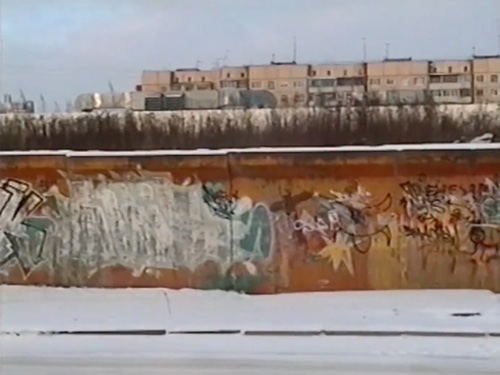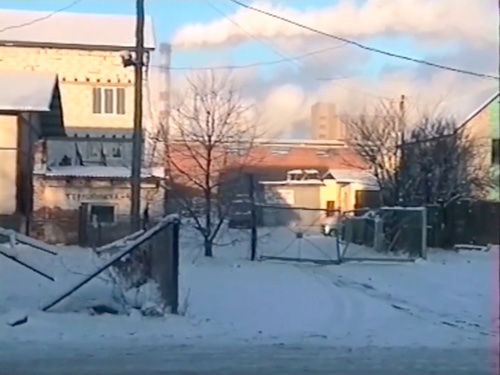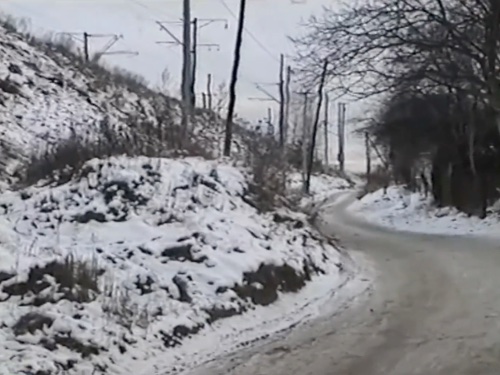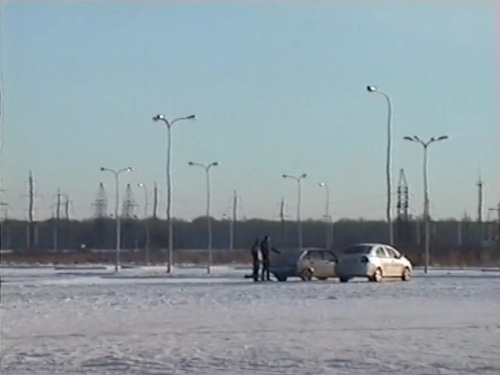Self-Organisation of History
An Interview with Yuriy Hrytsyna, Director of Varta1, Lviv, Ukraine (2015)
In February 2014, EuroMaidan took place. In the capital of Ukraine people took to the streets to demonstrate against the administration of President Viktor Yanukovych, who refused to sign the association agreement with the European Union and instead formed closer bonds with Russia. Tens of thousands of protestors from all over Ukraine went to Kyiv to demonstrate.
The filmmaker Yuriy Hrytsyna was living in Berlin at that time. He grew up in Lviv and had moved to Germany. He spent many hours glued to his screen, following streams of the events.
One year later he created a film called Varta1, Lviv, Ukraine. This film starts with a brief overview on the situation; “On February 18, 2014, activists of the Kyiv EuroMaidan begin a peaceful advance on the parliament. Police forces attack the protesters. People are killed, wounded, arrested. Riot police launch an anti-terrorist operation and storm the Maidan.”
In Lviv, after a spontaneous occupation of the regional government buildings by activists, the police forces withdraw, leaving a power vacuum. A self-organized group of volunteers decide to take over law enforcement functions in the city, using a peer-to-peer digital radio channel called “Varta1” (guard1), that formed the starting point for Hrytsyna’s film.
Varta1, Lviv, Ukraine is freely accessible on Vimeo. Sabzian had a conversation with Yuriy Hrytsyna about this work.

Nina de Vroome: Your film gives an insight into a unique situation in Ukrainian history, an example of a self-organised justice department, a horizontal and very temporary structure, in an effort to keep the citizens of Lviv safe and also to participate in the national political movements. In your biography we read that you are an anthropologist. Do you see making films as a tool for research?
Yuriy Hrytsyna: I call myself an anthropologist, but I don’t have a degree in anthropology. I see it more like guerrilla-anthropology. I have a degree in German language and literature and also in medicine. I am working as a doctor. It is a split personality, being a doctor and also being a filmmaker. My film studies were not in film school, but at Karagarga, an online film platform where I discovered many films, that made me realise all the possibilities we have in capturing the reality around us.
Yet, this is not my first film. I made a film in 2012, The Language and the World,1 that was also dealing with my hometown Lviv, which was hosting a European football championship. I tried to look anthropologically at what this event was doing to the city. How officials, entrepreneurs, intellectuals and professionals were creating a new image and new future for the city.
What triggered your fascination when you discovered the radio channel Varta1?
When I found it, I immediately knew it was something important, something historic. Since it’s a radio stream, it would disappear. So I recorded it a few days in a row. I didn’t have the time to listen to it right away, it was only months later that I noticed that these recordings were very interesting. They were characteristic for the things that were discussed in Maidan, Kyiv and in the whole of Ukraine. But nevertheless, it was a situation that was likely to be forgotten. The most important events took place in Kyiv, in the capital. There are a lot of images of that, but not of what happened in Lviv. This was a very decentralized event and all the people talking to each other with the walkie-talkies didn’t knew each other. They were there for this one goal and after that it would all evaporate. I thought it would be interesting not to look at the centre of the revolution, but rather at the periphery of it. These things were part of the revolution but didn’t belong to the grand narrative.
The recordings of Varta1 start after the escalation of police violence in Kyiv. The police attack on the 18th of February was extremely brutal; people were taken hostage and even killed, and people on Maidan and all-around Ukraine felt that it was a matter of hours before the police would unleash a final crackdown on the protesters’ camp on the Maidan. So everyone felt that they had to take action immediately. Activists thus gathered in front of the police stations and one military base of Lviv. There were plans to block these facilities, but then the situation escalated, the facilities were stormed and a lot of guns and ammunition were looted by unknown people, and till this day not all weapons could be retrieved. The city officials said that under these circumstances, fearing provocations, the police, which actually supported the EuroMaidan movement, could not function, so, technically speaking, state power ceased to exist in Lviv after the 18th of February 2014. Then the activists took over the police functions and organized the street patrols themselves. No one delegated it to them. They said that everyone who has a car could install this walkie talkie app on their phone. They were also streaming the conversations on the internet, for everyone to hear, because the channel was constantly overloaded. There were thousands of people listening, and there were several hundreds of people patrolling the streets in their cars. The idea was to make sure no looting would take place, and no criminal acts would be committed in the moment when there was no state power. The other goal was to retrieve the weapons and return them to the police, since no one wanted a dangerous situation with unknown people handling guns, even – or especially – at a time of revolution. The police cooperated with the activists, and in several cases when looters were captured they were turned over to the police, who handled them in the usual official way.
I was interested in how deradicalization of the conflict worked on the level of street democracy. This film portrays a situation that is potentially very dangerous; a mass of people taking power into their own hands and patrolling the street makes you think of the American “lynch justice”, but it did not end that way. I was interested in how the possibility of violence is discussed, contained and prevented.

How did the app of Varta1 work? There are people who are moderating the conversations. It is a horizontal structure which is nevertheless guided and controlled.
It was really a basic radio channel – one person talks, everyone listens. Then the next one talks. So, it had this linear structure where you could see how one theme develops over time only to be abruptly switched to another.
It is not known who the moderators were. One person we know about for sure, it is the man who later created a political party and online news media, both entitled “Varta1”, and got into the city council because he was the one who started the channel. A small group of moderators were helping him, making sure the channel was not used for criminal activities or the spreading of radical ideas. But they were not coordinating the patrols, they were organizing themselves.
The channel was not only used to locate suspects, but also to discuss what would happen to them once they were captured. The channel served as a medium to communicate with the civil patrols and the policemen who still provided assistance off-duty.
The punishment was always up for debate, and the moderators sometimes tried to lead the discussion without really imposing their certainties. How to punish an offender? And do you have to punish them at all? This was the main debate, and if there would not have been this conversation, I would not have made the film.
In the film there are two understandings of justice. There is the people’s understanding of justice, and the understanding of justice of the people who are in charge, the moderators, which is a more official understanding of justice. They are anticipating how this kind of justice could look the week after this and what the long-term consequences of this revolution will be.
In the film you see that different definitions of justice are being discussed and some new understanding is formed during these discussions. This is rare to witness.

These conversations sound rather casual and yet the very foundations of what a democracy or a state are are being discussed.
You are in Berlin, at a distance, you are doing this as if it were archaeological work, disconnected from the place and based on archival material of a year ago. Was this for you a way of coming closer, creating a closer relation with what was happening in your home town?
I didn’t need to hear this to understand what was happening. We had a lot of information at our disposal, which was different for people in the West, who were confronted with many contradictory narratives. I didn’t want to understand better, or be more connected, but I thought I had to archive this moment for the future. In 2014 and even in 2015, it was recent, and I wanted people to be able to look at it in 2025. I was interested in what this account will say to us in the future.
It shows that the seeds of self-organisation in 2014 are still growing and flourishing now. We see a new form of Russian-Ukrainian war. Since 2014 there was one war, now we have another form and it will evolve in another form later. What we see now is a crowd-funded war. People from all around the world and from Ukraine gather money and material, they organize on different levels and create networks of support and information exchange.
In 2014, the idea was that we were fighting for a right to be in Europe, and we are still doing this. Some things that were being discussed in 2014 look naive now. The idea of justice of some people did not take place, it is still to be developed in the future. We could achieve a lot after the revolution, however there are things that still need to be done. The war is postponing it and altering it as well. The Maidan revolution is the starting point of a metamorphosis that is still ongoing.

How did you start working on the film?
I listened for many hours to the recordings. I made a lot of notes and divided the conversations into categories. I wanted to reconstruct the revolution, and to understand the grammar of revolutionary speech. I had to establish the basic facts, like how does Varta1 function on a daily basis, how is it organized, what are the goals, and then my main interest was this behaviour of people in difficult situations, when things had to be negotiated. I was also interested in how people describe their environment, because it is a community of people listening to other people and they are not seeing what the others are seeing, so they depend on the ability of each other to describe what they are seeing and to interpret the things they have seen. I then contemplated which images would make sense to look at while listening to this material.
In February 2015 I went back to Lviv with a small Hi-8 tape camera, with a battery that had to load for a couple of hours and then I could only shoot 10 minutes a day. I had to have an idea what I wanted to shoot. In two weeks, I shot about two hours of footage. Out of these two hours of video I made one hour of film. I had to walk all over the city to find traces of revolution. I filmed urban environments that are not really associated with Lviv because it is considered to be a tourist destination, an old city with a lot of old history, and people travel there to visit the ancient city centre. I didn’t want to look at the city centre that is already in the people’s imagination but rather at the periphery, the post-industrial districts, where housing estates are, where the people live that actually led the revolution. These are the territories that were once seen as the future, but now became remnants of the past, which no one knew what to do with.
As a viewer we are imagining the characters as they are driving through the city, because the images show little information or action. Why did you choose this VHS camera which gives an image quality that seems old, from a time of even before 2014? It gives a nostalgic feeling.
VHS was something I associated with memory. My camera was unpredictable and gave different results all the time. This was for me a very concrete metaphor for memory, because a memory is not fixed, it depends on the way you remember it. It alters over time, by your imagination and by other memories. I thought this is a nice vehicle to let us understand that we are dealing with memories, not with actual events. I even thought of subtitling the film A Dream of Revolution. The image was also very beautiful, capturing the grey haze of Ukrainian winter months very well. This is how I remembered my childhood, the nineties: everything slightly out of focus, subdued colours all around, images distant, yet tangible.

Memories are like dreams; they emerge from a process of selection and recombination. Is the work of a historian or anthropologist a creative process as well?
One reference for me was the movement by surrealists in the United Kingdom, which was called ‘Mass-Observation’. It was cofounded in the 1930s by the great documentary filmmaker Humphrey Jennings and was especially huge during the Second World War. These artists and sociologists wanted to do anthropological research by going among people and recording what they said in great detail. Then they analysed the random dialogues they observed and out of this they made a study of society of Great Britain during this historical moment. This was what I wanted to do as well. I was listening to people talking about the world, and I also sensed that they were doing this for the first time, trying to find words for what they see, words for what they want to achieve. I was especially interested in this moment where people are grasping for words. In my case, anthropology and history are very subjective. The dialogues are selected and edited by me, so they kind of reflect my understanding of that revolution. The images also reflect the way I have seen Lviv all my life. So, in a way it is also a letter to myself through the words of other people.
At one point in the film, someone reports a car driving very slowly. When stopped, the driver declared he was “just killing time”. The civil patrol guard says: “Who drives around all alone when he could be staying at home?” Another one replies: “Don’t you ever drift around in your car alone?” The lonely spaces of cars are the actual “place of action” of your film, even though we don’t see them. The drifters are alone and yet they are connected with each other, reporting on everything they see. Driving too slowly is suspicious, but we also hear about cars driving too fast, for example the Porsche Cayenne. It seems like at one point, everyone is focused on this car and wanting to find out why this guy is speeding. Once arrested, it is being discussed what could be a legitimate reason for him to drive so fast. And they all assess the situation in a different way.
In the dialogues you hear how the Porsche Cayenne elusively appears and disappears, and finally gets captured. You hear that the activists are aware that it’s a very expensive car. They see a man that thinks he can speed around because he is rich. And then moderators decide to release him and take no action. The activists see this case as a concentrated image of something they had been fighting against their whole lives: the corrupted accumulation of wealth, the social injustice suddenly materialised in the form of a car. This car became important because it was an individual case, but also symbolic to their sense of equality and of justice. The discussions about what they should do with the driver transcended the specific situation; they were discussing the future shape of justice and of the revolution. These people were in Lviv, far away from Kyiv where the big history was taking place, but they also wanted to take part in history, and they thought that by doing something here in this situation they could play a role in it. It is often postulated that EuroMaidan was only about the idea of becoming part of the European community. But I think it was about a lot of different things for different people. And one can sense this in the film – for most this revolution is about experiencing justice. It can be difficult and unpredictable, but the moment one discusses justice one is discussing the fundaments of a new society.

Even people walking the street, or speeding in their car become part of history. Every moment of banality is charged with importance.
Everything is interconnected and influences everything, so every action matters. We see this from EuroMaidan, one action by one person can set everything in motion. It looks incredible, but very important events were brought about by very small people, and these were good or bad decisions, with different outcomes, but it reminds us that a lot depends on people who act and not on people who believe that history is made only by higher forces. The idea that self-organised groups have no agency, and individuals are an object and not a subject has done a lot of damage. I think my film reminds us that history can be present everywhere, and can

